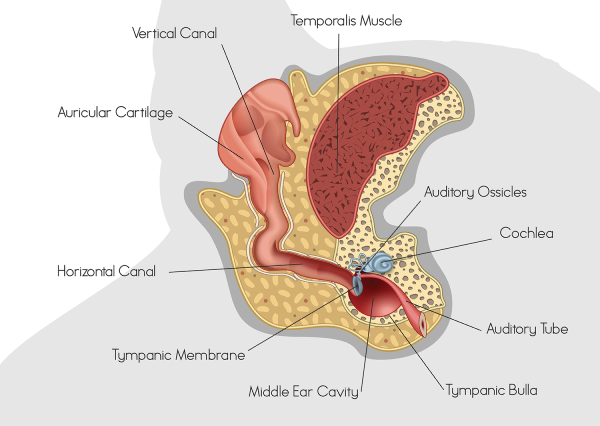
Primary Secretory Otitis Media (PSOM) in Dogs
Primary Secretory Otitis Media, commonly known as “Glue Ear,” is a condition primarily affecting dogs, especially Cavalier King Charles Spaniels and other brachycephalic breeds. However, it can also occur in humans and some other animals.
Research funded partly by the ACKCSC Charitable Trust found that 40% of the studied dog population exhibited symptoms of PSOM.
What is PSOM? PSOM is characterized by inflammation in the middle ear, where mucus builds up and creates a thick plug. If this blockage becomes significant, it can lead to pressure and pain due to the bulging of the tympanic membrane. The exact cause of PSOM remains unclear, though one theory suggests it may result from dysfunction in the Eustachian tube’s drainage process, leading to inadequate drainage or increased mucus production.
This condition can affect one or both ears. As the fluid accumulates, it can harden, causing a thick mucous plug that may result in hearing loss, balance issues, and discomfort. Its symptoms can resemble those of Syringomyelia (SM), another condition affecting Cavaliers.

Why are Cavaliers and Brachycephalic Breeds Affected? While PSOM is seen in various brachycephalic breeds, Cavaliers appear to be more frequently affected. There may be a hereditary component, though no conclusive genetic evidence has been established. The brachycephalic structure of a Cavalier’s head compresses the space within its muzzle, affecting the airways and drainage channels, including the Eustachian tube. Additionally, the breed’s ear shape and size could contribute to the condition.
Possible Symptoms PSOM may present clinical signs, although some dogs can be asymptomatic (referred to as “sub-clinical”). If symptoms occur, a veterinary examination is essential, as they can mimic other conditions. Notable symptoms may include:
- Hearing loss or lack of response to sounds.
- Neurological signs such as facial paralysis, head tilting, involuntary eye movements, and unsteady walking.
- Scratching or rubbing at the ears, indicating pain or irritation.
- Frequent yawning, as the dog may try to relieve ear pressure.
- Pain in the neck or scalp area.
Diagnosis In severe cases, PSOM can be identified via X-rays or an otoscopic examination. A veterinarian will perform a thorough physical check to exclude other issues like ear infections or mites. More advanced imaging, such as CT or MRI scans, may be necessary for accurate diagnosis, and a referral to a specialist might be required.
Treatment Options Treatment for PSOM varies based on severity and should be discussed with a veterinarian. Generally, it includes:
- Removal of the mucus plug and flushing of the middle ear through a procedure called myringotomy, often accompanied by corticosteroids and antibiotics.
- For milder cases, medications to thin mucus may help promote natural drainage.
- Severe cases might require surgical intervention via myringotomy, which involves a small incision in the eardrum under anesthesia.
- Another surgical option is a ventral bulla osteotomy, allowing access to the Eustachian tube through the neck.
Recurrence of mucus plugs is common, and dogs may need multiple treatments before achieving success. Overall, the prognosis for dogs with PSOM is generally positive.
